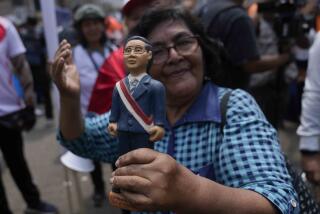THE FINANCING OF TERROR by James Adams (Simon & Schuster: $18.95; 265 pp.)
- Share via
When Juan and Jorge were abducted in Argentina in 1974, their grain-exporting firm paid Montoneros terrorists a ransom of $60 million. The demands also included distributing food and clothing worth an additional $1 million and installing busts of former President Juan Peron and wife, Eva, The Montoneros’ heroes, in all branch offices.
The bizarre terms set a record for hostage negotiations--until Washington and Jerusalem established a new precedent for concessions during recent arms deals with Iran to free five Americans and three Israelis held in Lebanon.
Terrorism is big business, James Adams proves in “The Financing of Terror,” one of the timeliest books of the year.
The sums are astronomical in promoting and paying off terrorists. In 1982, Adams claims, the Islamic republic allocated $100 million to create a network of clergy-dominated hit squads to terrorize regional and international rivals. An additional $50 million was to be doled out annually.
Meanwhile, the price tag of weaponry sold to Tehran by the United States and Israel is now estimated by a former government expert at no less than $500 million.
Yet Adams, an editor on The Sunday Times of London, wisely cautions that state sponsorship should not be overrated. Governments can exploit the deep-seated bitterness and rage of allies or surrogates, but rarely do they totally control their activities.
“The fact is that state sponsorship--the funding, training and arming--of terrorists groups plays a very small part in the current growth of terrorism.” He claims that applies equally to the Soviet Union, Libya and Cuba, who pay more in lip service than in cash extremists.
“Most so-called support for terrorist groups by various countries is actually characterized by disloyalty and whim,” he writes. The Palestine Liberation Organization, for example, has to pay cash for Soviet weaponry--in U.S. dollars. And a widely publicized 1983 pledge of financial largess is just one of many that Libyan leader Moammar Kadafi never paid the PLO.
As a result, most groups have become increasingly self-sufficient. “Today’s terrorists are hybrids. They have learned that state support is unreliable, and if they and their groups are to survive, they have to look to their own resources.”
That apparently determined the fate of at least one hostage in Lebanon. Peter Kilborn was reportedly held by a group demanding a multimillion-dollar ransom. Some U.S. officials now believe that, when the money was not forthcoming, Kilborn was “sold” to a pro-Libyan group. He was killed in April in retaliation for the U.S. air raid on Libya.
But the most graphic example is the PLO, which, according to sources unspecified by the author, earns an estimated $1.25 billion annually from $5 billion worth of investments in Wall Street, Paris and London real estate, a Belgian charter airline, a Cyprus-based shipping company and other holdings, Adams reveals.
The world’s most notorious guerilla movement is run as a multinational corporation, with farms and industries throughout the Middle East and Africa. Until its expulsion after the 1982 Israeli invasion, PLO, Inc. was the second largest civilian employer in Lebanon--not including its massive militia. One branch manafactured clothing and crafts exported to a dozen countries.
It also raises funds through a 5% tax on Palestinians worldwide and Arab government donations of as much as $250 annually. More militant factions have also peddled drugs, the author reports, in defiance of chairman Yasir Arafat’s orders.
“All those terrorists groups that survived the ‘60s, when world revolution seemed just around the corner, have modified their political stand with a healthy dose of sound capitalism,” the author concludes.
In general, however, drugs and kidnapings yield the biggest bucks. Left-wing terrorists in Colombia earned almost $3.4 million every month through an alliance with cocaine smugglers; the powerful alliance subverted the economy, undermined the government--and inspired groups in Bolivia, Peru and Chile.
Despite President Reagan’s apparent obsession with U.S. hostages, kidnapings are not limited to Americans in the Middle East. Between 1968-82, 951 hostages were taken in 73 countries. And the victims are not always human. In 1983, the IRA demanded a $3 million ransom after abducting Shergar, the Irish Derby-winning stallion.
And terrorists are not the only ones to pocket profits. The biggest growth area for Lloyd’s of London over the last 10 years has been in ransom insurance for vulnerable business executives and politicians. In effect, a whole new economy has grown up around terrorism.
“The Financing of Terror” is a cool-headed and informative analysis in what has otherwise been a year of hysterical literature on a controversial subject. It is not a definitive expose, but by examining a variety of case studies in Europe, Latin America and the Middle East, Adams offers an important insight into how terrorists survive, and occasionally thrive.
The economics of terrorism also have important policy implications. His conclusion, that the most effective way to combat terrorists is to stem their economic power base, is debatable. But it is certainly an original angle that counterterrorists should explore to combat what is now generally perceived by the public as a greater threat to national security than communism.
More to Read
Sign up for Essential California
The most important California stories and recommendations in your inbox every morning.
You may occasionally receive promotional content from the Los Angeles Times.













